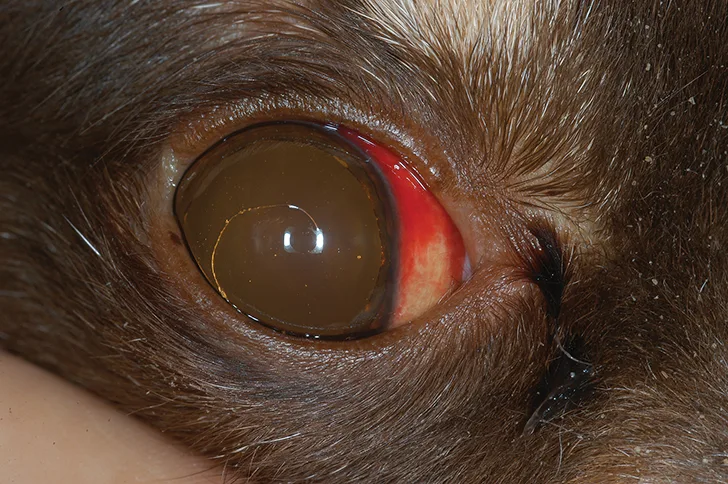This response is correct!
Subconjunctival Hemorrhage in Dogs
Georgina M. Newbold, DVM, DACVO, The Ohio State University
In the Literature
Saastamoinen J, Rutter CR, Jeffery U. Subconjunctival haemorrhage in 147 dogs. J Small Anim Pract. 2019;60(12):755-760.
The Research …
When a patient is presented for red and/or bruised ocular tissue, there may be concern for trauma or nonaccidental injury/physical abuse. In a large study of pets presented for traumatic injury, subconjunctival hemorrhage (ie, bleeding between the conjunctiva and sclera) was associated with nonaccidental injury.1
However, there are several nontraumatic causes of subconjunctival hemorrhage that must be ruled out to avoid missing a systemic problem. These causes, in addition to cases of known trauma, were investigated in a recent study. Medical records of 147 dogs with subconjunctival or scleral hemorrhage were retrospectively analyzed. In 81% of dogs, subconjunctival hemorrhage was attributed to a traumatic event (eg, vehicular trauma, animal attack); of these cases, <5% were the result of nonaccidental injury. The remaining 19% of patients were determined to have a primary systemic or ocular problem that led to subconjunctival bleeding. Because a significant number of patients in this study had distinct systemic causes for subconjunctival hemorrhage, it is important to consider diagnoses other than trauma or nonaccidental injury.

Subconjunctival hemorrhage in a 6-year-old German wirehaired pointer with immune-mediated thrombocytopenia
… The Takeaways
Key pearls to put into practice:
When patients with subconjunctival hemorrhage are assessed, a thorough history, including the potential for unwitnessed trauma, should be obtained. A complete physical examination is necessary to look for evidence of puncture or bite wounds or abrasions. The patient should also be examined closely for any signs of petechiation or ecchymoses. A thorough ocular examination should be performed to assess for other signs of bleeding (eg, hyphema, iridal hemorrhage, retinal hemorrhage). Presence of additional intraocular signs may indicate a systemic problem or primary ocular condition (eg, glaucoma, orbital mass).
Diagnostic testing is important in cases in which trauma is not strongly suspected or observed. Blood pressure >160 mm Hg may be a concern for systemic hypertension, but pain, stress, and anxiety following trauma can also cause transient elevation in blood pressure. CBC, including platelet count, and prothrombin and activated partial thromboplastin times (aPTT) should be performed to rule out coagulopathies such as immune-mediated thrombocytopenia and rodenticide toxicity (Figure). A serum chemistry profile is also recommended to look for bleeding disorders secondary to acute liver injury or toxicity. In some cases, vasculitis secondary to rickettsial disease, envenomation, and/or another inflammatory condition may lead to a bleeding disorder.
Although nonaccidental injury is possible, subconjunctival hemorrhage may signal a bleeding disorder rather than abuse or trauma.
You are reading 2-Minute Takeaways, a research summary resource presented by Clinician’s Brief. Clinician’s Brief does not conduct primary research.